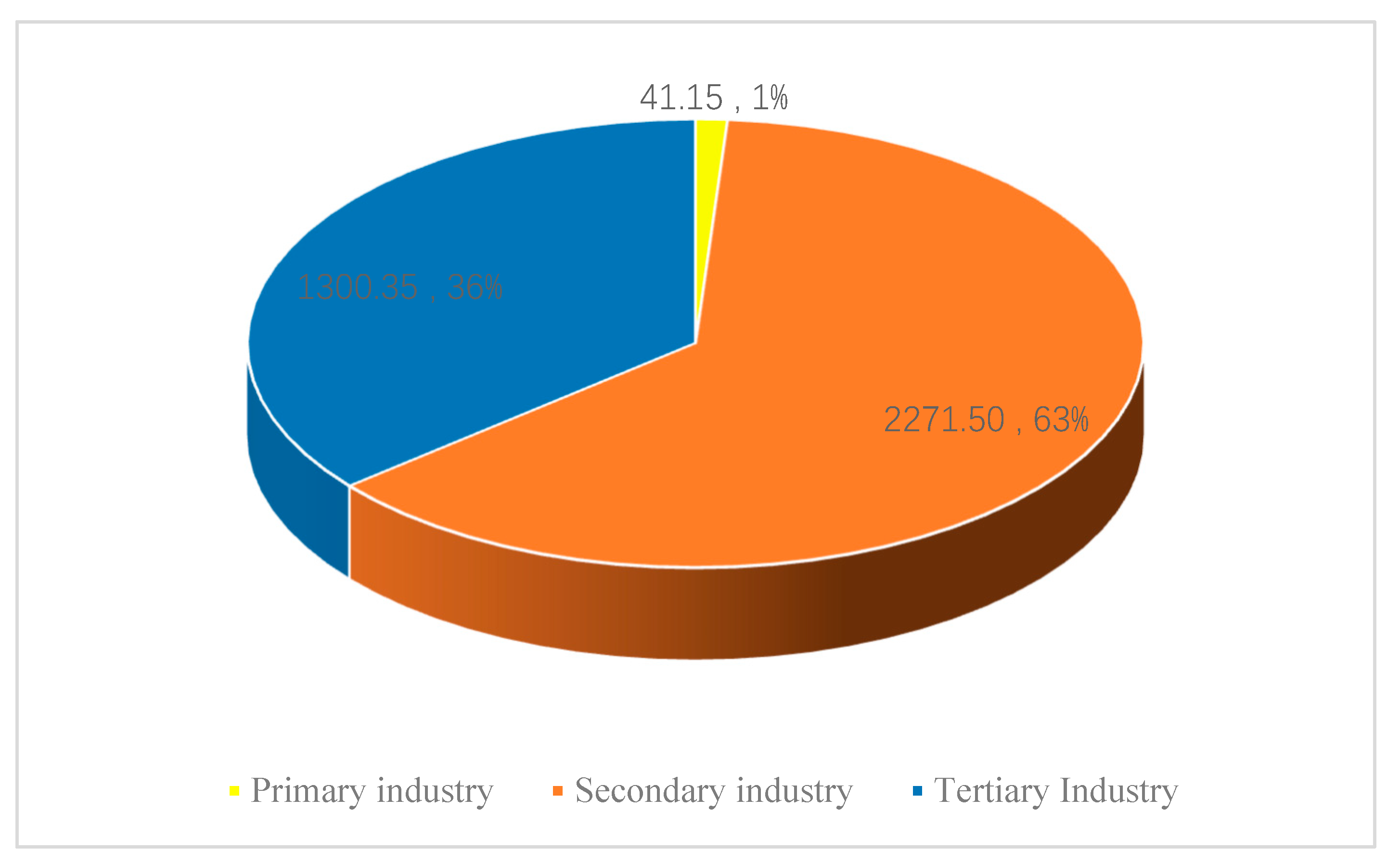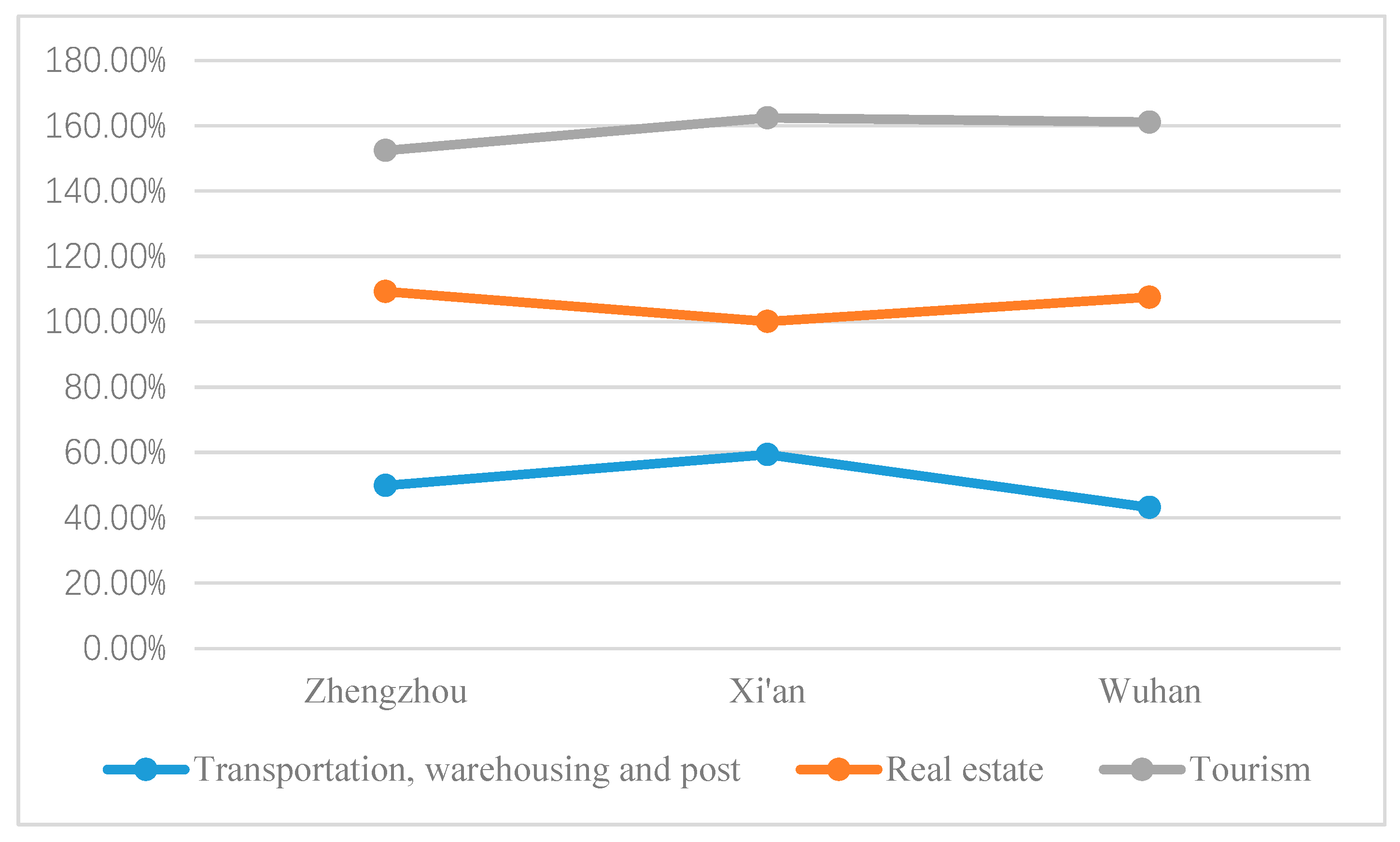3.2. Input-Output Model
The input-output model is divided into two categories [
44]. These categories entail a physical input-output model, and a value input-output model. The comparison between the two is shown in
Table 1.
Through the comparative analysis of the physical input-output model, and the value input-output model, as seen in
Table 1, it can be observed that the value input-output model has a wider scope of application. Therefore, the value input-output model has been selected in order to study the pulling effect of high-speed railway in terms of the derivative industries. Additionally, the value input-output model is shown in
Table 2.
From the perspective of the input-output table, the balance between the output of intermediate products, the output of total products, and the output of the final products in each production department, can be expressed as follows:
The system of equations can be simplified to Equation (2), which is shown as:
From the column orientation of the table, the input-output table describes the balance between the input volume of intermediate products, the newly created value, and the total input of each industry. Thus, the newly created value can be expressed as follows:
where,
, which represents the newly created value.
Therefore, the system of equations can be simplified to Equation (4):
The total input in the final row, and the total output in the final column are quantitatively balanced, which can be expressed as follows:
The final product, and newly created value are also balanced in terms of the quantity, which can be expressed as follows:
According to the principles of the input-output analysis model, in order to calculate the newly created value of the high-speed railway, in the context of the related industries, it is necessary to obtain specific index values according to the calculation formulas of the row model and the column model:
1. The relationship between the total product and the final product in the line model.
The direct consumption coefficient often appears as an input coefficient or an intermediate input coefficient. In this regard, if
represents the direct consumption coefficient, then
essentially refers to the number of i products consumed, per product unit
j product, of the j industry.
Moving further, In Equation (7), refers to the number of products, consumed by industry, where refers to industry’s total intermediate input.
Moreover,
reflects the strength of the connection between the two industries
and
. In interpretation of the equation, the larger the value, the closer the connection between the two industries. Incorporating the direct consumption coefficient formula into Formula (2), the relationship between the total product and the final product is shown in Equation (8).
In Equation (8),
refers to the total product, and
refers to the final product. The deformation of Formula (8) can be obtained as: (I is the identity matrix).
which can be expressed as follows:
where,
,which is the total product matrix;
, which is the final product matrix; and
, which is the direct consumption coefficient matrix.
2. The relationship between the incremental output value created by each industry sector, and the total input in the column model.
Substituting the direct consumption coefficient formula into Formula (4), the product distribution equation relationship between the total incremental input and output value, created by each industrial sector, is shown in Equation (10):
In this regard, the above Equation (10) can be transformed into Equation (11):
which can further be expressed as follows:
where,
which is the total input matrix;
,which is the value increment matrix created by various industrial sectors; and
, which is the consumption coefficient matrix of each substance.
According to the principles of the input-output balance, the total output and total input are numerically equal:
Therefore, the above formulas are combined into Equation (14):
which can also be expressed as follows:
Thus, we can observe that in order to calculate the incremental increase in the output value that is created by the investment driven demand of a high-speed railway, in various industrial sectors, we only need to take into account the final products produced by various sectors of the national economic system, and the consumption coefficient matrix (the formula derivation above refers to References [
38,
44]).
3.3. Quantitative Analysis
The input-output table is compiled once every five years. Moreover, the input-output coefficient related data referred to in this study has been extracted from China’s input-output table, based on 149 departments, specifically pertaining to the year 2017. In this table, the railway passenger transportation industry, railway freight transportation and transportation auxiliary activities industry, and railway transportation equipment manufacturing industry, are categorized as independent industries. Moreover, the high-speed railway investment data comes from China’s Railway Yearbook 2018.
3.3.1. Connections and Linkages between High-Speed Railway and Related Industries
Table 3 shows the top 15 industries in the input-output table that are related to the complete consumption coefficient of high-speed railway-related industries. that is to say, the most important supply sectors related to the high-speed railway, ordered in terms of their critical factor, include: monetary finance and other financial services, electricity, heat production and supply, electronic components et al., and the three least important supply sectors in the table are road goods transportation and auxiliary transportation activities, real estate and, finally, coal mining and washing products. From the perspective of the complete consumption coefficient, the high-speed railway industry carries the largest sum of direct and indirect consumption in the following 15 sectors, and is the most closely related to them. That is to say, the increase in high-speed railway investment has a significant amount of direct and indirect consumption in the related industries that are mentioned in
Table 3, and thus, this puts this initiative in a sturdy leading role as well.
3.3.2. High-Speed Railway’s Contribution to the Total Output of Various Industries
According to the complete consumption coefficient presented in the input-output table, the simple output multiplier value of the high-speed railway initiative is 4.39. The complete consumption coefficient table shows that, for every unit of investment provided by high-speed railway, it can generate a total demand of 4.39 units, for each related industry. In 2017, the total investment scale of China’s railway’s fixed assets was 823.08 billion Yuan. After the year 2012, the growth rate of high-speed railway investment has stabilized, and has also been connected to the inland sector. According to the China Railway Corporation’s “Completion of National Railway Major Indicators” statistics, after the year 2011 most of China’s investment pertaining to railway capital construction was dedicated to high-speed railway construction. Therefore, the total investment of China’s railway’s fixed assets, in the year 2017, can be deliberated as exclusively high-speed railway investment. According to formula 15, the pulling effect of high-speed railway investment on the output of various industries can thus be calculated accordingly.
In 2017, the investment that went into high-speed railway was 823.08 billion Yuan, and the total output change of the 149 industries that have been taken into account was 3613 billion Yuan. Among these industries, the top 15 with the largest increase in total output altogether produced 1950.53 billion-Yuan. This accounted for 54% of the total output of the entire industry. It can be concluded that the input of high-speed railway has had a colossal impact on the total output of secondary industry. As shown in
Figure 1, the total output changes of secondary industry totaled 2271.5 billion-Yuan, accounting for 63% of the total output changes. Also, the total output of the tertiary industry was stipulated to be 1300.35 billion-Yuan, accounting for 36% of the total output change. Thus we can observe that this particular sector has had little effect on primary industry.
It can be grasped that the investment in the construction of high-speed railways has a significant and complete economic pulling effect on the surrounding industries, such as non-metallic mining and dressing, non-metallic mineral products, metal mining and dressing, and metal smelting and rolling processing industries. Industries, transportation equipment manufacturing, general purpose equipment manufacturing, and other industries also have a greater direct economic pull effect.
High-speed railway construction investment has led to a boost in the economic scale of industries, such as railway construction, railway transportation equipment manufacturing, and communication signal manufacturing. It has also promoted and upgraded the industrial technology innovation processes. The spillover effects of China’s high-speed railway technology economy are thus showing their impact in a positive manner.










